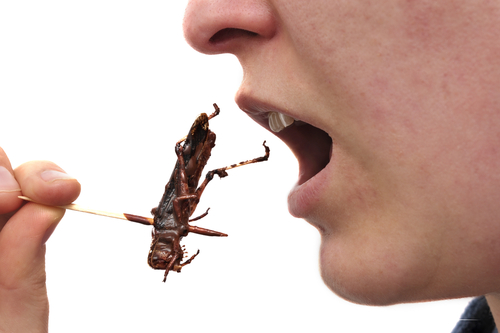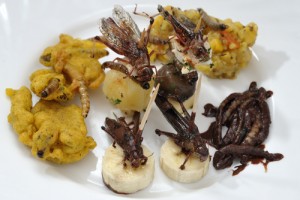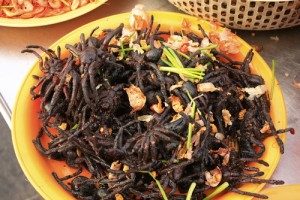 I spent the summer cultivating an increasing desperation to eat an insect.
I spent the summer cultivating an increasing desperation to eat an insect.
The first hankerings developed as I spent a couple of months researching and editing a feature on entomophagy for New Scientist — after sifting through enough butter roasted locust risottos and lemon pepper cricket broths, the idea went full spectrum from hilariously gross to somewhat intriguing to egg-and-bacon sandwich for a hangover. By the time the feature came out, I was full-on jonesing.
Given all the hype, you would have thought it would be easier to scratch my six-legged itch.
Especially as this year, London was in the grip of something of a “Summer of Bug”. There was Pestival, an insect-eating event that featured recipes put together by world-class Noma chefs. There were insect tastings along the tourist-friendly South Bank. There were pop up restaurants and canapé tasting events organised by vodka companies.
 Consider what happened when I tried to blag my way into Pestival. The multi-course insect dinner was sold out immediately, but Sandrine — who was writing the feature — wrangled a press pass for research purposes. I figured they’d let her squeeze in a plus one if it was her editor; I could simply show up and throw around a little editorial weight. Yeah, no, the nice gentleman told me at the door. We’re sold out. Okay, okay, I conceded: I’ll pay for a seat. The nice gentleman raised his eyebrow. We’re sold out, he said more slowly. No seats. Okay, nice gentleman, I thought. Two can play that game. I’ll just lurk around uncomfortably until they relent and just let me eat some of their bugs. So I sat on a nearby couch, watching the food get dished out, and taking notes as Sandrine and about 50 others sipped ant gin and ate locust risotto. It took me 90 minutes to get the hint — it wasn’t going to happen.
Consider what happened when I tried to blag my way into Pestival. The multi-course insect dinner was sold out immediately, but Sandrine — who was writing the feature — wrangled a press pass for research purposes. I figured they’d let her squeeze in a plus one if it was her editor; I could simply show up and throw around a little editorial weight. Yeah, no, the nice gentleman told me at the door. We’re sold out. Okay, okay, I conceded: I’ll pay for a seat. The nice gentleman raised his eyebrow. We’re sold out, he said more slowly. No seats. Okay, nice gentleman, I thought. Two can play that game. I’ll just lurk around uncomfortably until they relent and just let me eat some of their bugs. So I sat on a nearby couch, watching the food get dished out, and taking notes as Sandrine and about 50 others sipped ant gin and ate locust risotto. It took me 90 minutes to get the hint — it wasn’t going to happen.
And over the next few weeks, every stray moth, ant and mosquito became a frustrating reminder of what I was unable to procure. Everything was sold out! All the time!
In light of this heavy demand for insect fare, it’s tempting to say that insects are the new sushi. More than one person has made the connection. And there are parallels. In the early ‘80s, raw fish was a food seen by Americans as foreign and fairly extreme. Then hipsters began snacking on it in public displays of sophistication, gleefully horrifying the meat-and-potatoes set as they do. Within a short time, sushi restaurants were established in New Jersey strip malls. In 2003, they were slinging sushi at the food court in a mall in Towson, Maryland. Nowadays, in New York, sushi counts as comfort food. You eat it in your PJs with basic cable.
It’s easy to see the beginnings of a similar trend for insects. A few years ago, telling someone you eat crickets would have made you sick in your mouth. Then high end chefs in San Francisco got involved. Insect tastings became de rigeur. Before long, everyone will be ordering the Locust Nigiri.
But as tempting as it is to see the parallels, that scenario is actually very unlikely to pan out. As Sandrine found, despite the UN recommendation to add insects as a global source of protein, there are logistical problems with getting them into a food supply where they haven’t traditionally been eaten. These range from breeding the right varieties to keep hot-weather insects alive in the cold northern climes to making sure you know what they’ve been eating, to farming them to make sure they don’t escape.
But there’s a far bigger sticking point: legs.
 Eat a cricket, locust or a fried centipede on a stick, and you’ll probably find yourself smiling with a leg peeking out from behind an incisor. And that mouth-feel is zero fun, as I can attest from having to floss one out after sampling a cricket bar that tasted otherwise disappointingly insect-free.
Eat a cricket, locust or a fried centipede on a stick, and you’ll probably find yourself smiling with a leg peeking out from behind an incisor. And that mouth-feel is zero fun, as I can attest from having to floss one out after sampling a cricket bar that tasted otherwise disappointingly insect-free.
Julene Aguirre-Bielschowsky and her team at Ento, a London design startup that is trying to normalise insect eating, have a different idea. They think the best way to get insect protein into the Western diet is to skip the hipster step. To that end, they are designing insects to be eaten in disguised form. They grind them up and fold them into sweet potato croquettes or into little zucchini pancakes. The flavours of these insects are unique and delicious (especially honey caterpillar, which tastes like a gamey cousin of egg – and no, I am not a food writer, so I realise I am not selling this brilliantly). And instead of focusing on all the hype and luck and word of mouth that goes into a restaurant, Ento aims to create foods that will go directly to supermarkets, packaged as familiar, safe-looking fare that will hang out next to the other snack foods. “We want it to be as unthreatening as hummus,” Aguirre-Bielschowsky told me. The only difference will be the protein source inside. Eventually, she sees insects being sold as uncontroversially as ground meat.
And maybe she’s right: focusing on the flavor over the novelty seems like a better way to win over the meat & potatoes types, especially here in the UK.
Sandrine also found a study of Flemish attitudes toward meat alternatives, which revealed that when foods tried too hard — by struggling to imitate the flavors of familiar staples like chicken or beef — people quickly tired of them. But foods like tofu, which were simply honest about their own flavors, those were a hit — people tended to stick with those in the long term. “Insects are their own thing,” B told me. “We’re still trying to figure out where they fit into this culinary culture.”
 Can insects be folded seamlessly into our Western palates this way? Say in a tofu-like agglomeration made from insects that you can pick up at the local grocery store and throw into a nice Spaghetti Bolognese? An otherwise inoffensive croquette that gets its protein and a specific flavor from the crickets and honey caterpillars adding an exotic twist to the familiar flavor of sweet potato? Or will insects take the long road to acceptance, via insect chomping hipsters?
Can insects be folded seamlessly into our Western palates this way? Say in a tofu-like agglomeration made from insects that you can pick up at the local grocery store and throw into a nice Spaghetti Bolognese? An otherwise inoffensive croquette that gets its protein and a specific flavor from the crickets and honey caterpillars adding an exotic twist to the familiar flavor of sweet potato? Or will insects take the long road to acceptance, via insect chomping hipsters?
My money is on the former. Judging from my experience, the power of suggestion is huge — having journeyed from mild aversion to curiosity to mild interest, I am still frustrated by my inability to find a nice crunchy butter locust risotto.
Photo credits
Bowl of Argh! Shutterstock
Meat: Shutterstock
I can’t eat shellfish because I’m allergic, and I think it’s the tropomysin in their muscles that’s responsible. If I can’t stomach crustacean tropomysin, surely insect tropomysin isn’t gonna be much fun either? Is there any allergy information given out at these events?
Sally says, via Ann: “Sally is indisposed, but would like you to know that yes, the same chitin you find in shellfish will be an issue if you want to eat crickets and locusts, because of their exoskeleton. But tell him he’s all cleared for takeoff if he’s looking to sample some delicious mealworms! or honey caterpillar!” Sally supplies the following helpful link: http://www.insecteneten.nl/en/news-articles/insects-and-allergy/. Ann thinks Sally and Ed both are nuts.
Oh sure, Ed. Tropomysin allergies, that’s why you won’t eat bugs. Personally, I’m allergic to the idea of Sally picking bug legs out of her teeth — even writing that give me hives.
Intellectually I’m all for eating insects, but I don’t think I could do it unless it was disguised. Maybe insect protein protein could be marketed as a health food and blended into smoothies.